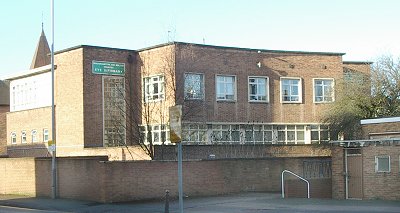|

Local Listing:
The Outpatients'/Accident and Emergency Extension was built in 1937,
just ten years after the Nurses' Home, but it belongs to an entirely different
architectural world. The architect was Richard Twentyman (1903-79) of Lavender
and Twentyman, which was probably the most important architectural practice
working in Wolverhampton in the middle of the 20th century. Other important
buildings by Twentyman include St. Martin's Church, Dixon Street which, despite
its recent date (1938‑9), is Statutorily Listed (Grade II) and St. Andrew's
Church, St. Andrew's Close and Bushbury Crematorium, Bushbury Lane both of which
are included in the Council's Local List.
His building followed the principles of the International Modern
Movement which rejected historic precedent as a source of architectural
inspiration and considered function as the prime generator of form, using
materials and technology in an entirely honest way. It is made up of a series of
one‑ and two‑storey red brick boxes surmounted by flat roofs with projecting
concrete parapets. The north and south elevations are parallel with the Compton
and Merridale Roads respectively and these are connected at their east ends by a
two-storey, concave brick wall facing towards Chapel Ash. Windows are square or
rectangular and set into deep concrete reveals, some with concrete mullions.
Internally, an intervening mezzanine level provides impressive, light and airy
double height spaces for the waiting hall and consulting room.
Comment: There are three principal buildings on this site: the original Infirmary
of 1888; the Nurses' Home of 1927; and the Outpatients'/Accident and Emergency
Extension of 1937. These buildings are quite different in style but all are of
definite architectural and historic interest and all were designed by
significant local architects.
All three buildings are locally listed and all are in the Oaks
(Merridale Road) Conservation Area.
The notes under Local Listing” above are taken from the Conservation Area
Appraisal and are therefore somewhat more comprehensive than the usual local
listing notes. A full history of
the Infirmary can be found on this site if you
follow this link. It will be apparent that the Eye Infirmary has been very
important in the social and health history of the city.
It has been a greatly appreciated facility in which there was a good deal
of local pride.
The local health care trust decided, in 2004, to close the Eye
Infirmary, sooner rather than later, and move its services to somewhere else,
unspecified and apparently unknown.
These buildings are, therefore, at risk and sympathetic new uses need to be
found for them. As the grounds in
which they stand are now crowded and suffering from poor landscaping and
neglect, any re-development should be treated as an opportunity to greatly
improve the setting of these buildings.

|